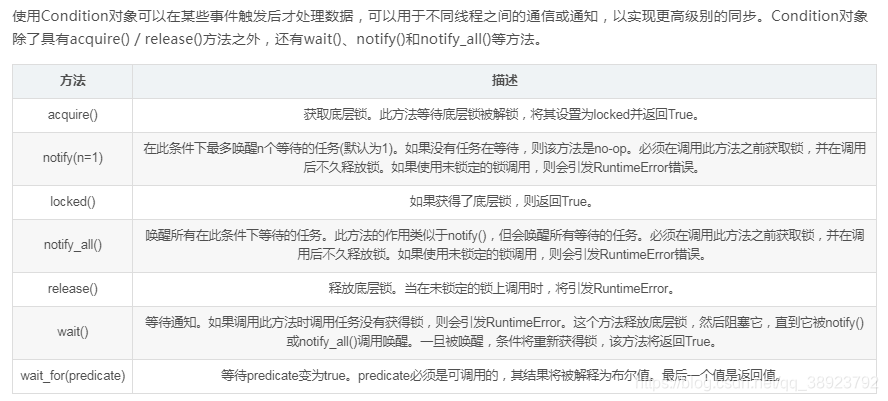1.线程执行
join与setDaemon
-
1.子线程在主线程运行结束后,会继续执行完,如果给子线程设置为守护线程(setDaemon=True),主线程运行结束子线程即结束;
-
2 .如果join()线程,那么主线程会等待子线程执行完再执行。
import threading
import time
def get_thread_a():
print("get thread A started")
time.sleep(3)
print("get thread A end")
def get_thread_b():
print("get thread B started")
time.sleep(5)
print("get thread B end")
if __name__ == "__main__":
thread_a = threading.Thread(target=get_thread_a)
thread_b = threading.Thread(target=get_thread_b)
start_time = time.time()
thread_b.setDaemon(True)
thread_a.start()
thread_b.start()
thread_a.join()
end_time = time.time()
print("execution time: {}".format(end_time - start_time))
thread_a是join,首先子线程thread_a执行,thread_b是守护线程,当主线程执行完后,thread_b不会再执行
执行结果如下:
get thread A started
get thread B started
get thread A end
execution time: 3.003199815750122
2.线程同步
多线程间共享全局变量,多个线程对该变量执行不同的操作时,该变量最终的结果可能是不确定的(每次线程执行后的结果不同),如:对count变量执行加减操作 ,count的值是不确定的,要想count的值是一个确定的需对线程执行的代码段加锁。
3.线程同步的方式
3.1 锁机制

python对线程加锁主要有Lock和Rlock模块
Lock:
from threading import Lock
lock = Lock()
lock.acquire()
lock.release()
Lock有acquire()和release()方法,这两个方法必须是成对出现的,acquire()后面必须release()后才能再acquire(),否则会造成死锁
Rlock:
鉴于Lock可能会造成死锁的情况,RLock(可重入锁)对Lock进行了改进,RLock可以在同一个线程里面连续调用多次acquire(),但必须再执行相同次数的release()
from threading import RLock
lock = RLock()
lock.acquire()
lock.acquire()
lock.release()
lock.release()
当一个线程调用锁的acquire()方法获得锁时,锁就进入“locked”状态。每次只有一个线程可以获得锁。如果此时另一个线程试图获得这个锁,该线程就会变为“blocked”状态,称为“同步阻塞”(参见多线程的基本概念)。
直到拥有锁的线程调用锁的release()方法释放锁之后,锁进入“unlocked”状态。线程调度程序从处于同步阻塞状态的线程中选择一个来获得锁,并使得该线程进入运行(running)状态。
3.2 Semaphore(信号量)
信号量也提供acquire方法和release方法,每当调用acquire方法的时候,如果内部计数器大于0,则将其减1,如果内部计数器等于0,则会阻塞该线程,直到有线程调用了release方法将内部计数器更新到大于1位置。
Semaphore(信号量)是计算机科学史上最古老的同步指令之一。Semaphore管理一个内置的计数器,每当调用acquire()时-1,调用release() 时+1。计数器不能小于0;当计数器为0时,acquire()将阻塞线程至同步锁定状态,直到其他线程调用release()。
基于这个特点,Semaphore经常用来同步一些有“访客上限”的对象,比如连接池。
BoundedSemaphore 与Semaphore的唯一区别在于前者将在调用release()时检查计数器的值是否超过了计数器的初始值,如果超过了将抛出一个异常。
构造方法:
Semaphore(value=1): value是计数器的初始值。
import time
import threading
def get_thread_a(semaphore,i):
time.sleep(1)
print("get thread : {}".format(i))
semaphore.release()
def get_thread_b(semaphore):
for i in range(10):
semaphore.acquire()
thread_a = threading.Thread(target=get_thread_a, args=(semaphore,i))
thread_a.start()
if __name__ == "__main__":
semaphore = threading.Semaphore(2)
thread_b = threading.Thread(target=get_thread_b, args=(semaphore,))
thread_b.start()
3.3 条件判断
所谓条件变量,即这种机制是在满足了特定的条件后,线程才可以访问相关的数据。
它使用Condition类来完成,由于它也可以像锁机制那样用,所以它也有acquire方法和release方法,而且它还有wait,notify,notifyAll方法。

"""
一个简单的生产消费者模型,通过条件变量的控制产品数量的增减,调用一次生产者产品就是+1,调用一次消费者产品就会-1.
"""
"""
使用 Condition 类来完成,由于它也可以像锁机制那样用,所以它也有 acquire 方法和 release 方法,而且它还有
wait, notify, notifyAll 方法。
"""
import threading
import queue,time,random
class Goods:#产品类
def __init__(self):
self.count = 0
def add(self,num = 1):
self.count += num
def sub(self):
if self.count>=0:
self.count -= 1
def empty(self):
return self.count <= 0
class Producer(threading.Thread):#生产者类
def __init__(self,condition,goods,sleeptime = 1):#sleeptime=1
threading.Thread.__init__(self)
self.cond = condition
self.goods = goods
self.sleeptime = sleeptime
def run(self):
cond = self.cond
goods = self.goods
while True:
cond.acquire()#锁住资源
goods.add()
print("产品数量:",goods.count,"生产者线程")
cond.notifyAll()#唤醒所有等待的线程--》其实就是唤醒消费者进程
cond.release()#解锁资源
time.sleep(self.sleeptime)
class Consumer(threading.Thread):#消费者类
def __init__(self,condition,goods,sleeptime = 2):#sleeptime=2
threading.Thread.__init__(self)
self.cond = condition
self.goods = goods
self.sleeptime = sleeptime
def run(self):
cond = self.cond
goods = self.goods
while True:
time.sleep(self.sleeptime)
cond.acquire()#锁住资源
while goods.empty():#如无产品则让线程等待
cond.wait()
goods.sub()
print("产品数量:",goods.count,"消费者线程")
cond.release()#解锁资源
g = Goods()
c = threading.Condition()
pro = Producer(c,g)
pro.start()
con = Consumer(c,g)
con.start()
Condition内部有一把锁,默认是RLock,在调用wait()和notify()之前必须先调用acquire()获取这个锁,才能继续执行;当wait()和notify()执行完后,需调用release()释放这个锁,在执行with condition时,会先执行acquire(),with结束时,执行了release();所以condition有两层锁,最底层锁在调用wait()时会释放,同时会加一把锁到等待队列,等待notify()唤醒释放锁
wait() :允许等待某个条件变量的通知,notify()可唤醒
notify(): 唤醒等待队列wait()
# encoding: UTF-8
import threading
import time
# 商品
product = None
# 条件变量
con = threading.Condition()
# 生产者方法
def produce():
global product
if con.acquire():
while True:
if product is None:
print 'produce...'
product = 'anything'
# 通知消费者,商品已经生产
con.notify()
# 等待通知
con.wait()
time.sleep(2)
# 消费者方法
def consume():
global product
if con.acquire():
while True:
if product is not None:
print 'consume...'
product = None
# 通知生产者,商品已经没了
con.notify()
# 等待通知
con.wait()
time.sleep(2)
t1 = threading.Thread(target=produce)
t2 = threading.Thread(target=consume)
t2.start()
t1.start()
3.4 同步队列
put方法和task_done方法,queue有一个未完成任务数量num,put依次num+1,task依次num-1.任务都完成时任务结束。

import threading
import queue
import time
import random
'''
1.创建一个 Queue.Queue() 的实例,然后使用数据对它进行填充。
2.将经过填充数据的实例传递给线程类,后者是通过继承 threading.Thread 的方式创建的。
3.每次从队列中取出一个项目,并使用该线程中的数据和 run 方法以执行相应的工作。
4.在完成这项工作之后,使用 queue.task_done() 函数向任务已经完成的队列发送一个信号。
5.对队列执行 join 操作,实际上意味着等到队列为空,再退出主程序。
'''
class jdThread(threading.Thread):
def __init__(self,index,queue):
threading.Thread.__init__(self)
self.index = index
self.queue = queue
def run(self):
while True:
time.sleep(1)
item = self.queue.get()
if item is None:
break
print("序号:",self.index,"任务",item,"完成")
self.queue.task_done()#task_done方法使得未完成的任务数量-1
q = queue.Queue(0)
'''
初始化函数接受一个数字来作为该队列的容量,如果传递的是
一个小于等于0的数,那么默认会认为该队列的容量是无限的.
'''
for i in range(2):
jdThread(i,q).start()#两个线程同时完成任务
for i in range(10):
q.put(i)#put方法使得未完成的任务数量+1
3.5 Event对象
Event对象是一种简单的线程同步通信技术,一个线程设置Event对象,另一个线程等待Event对象。

import threading
# 自定义线程类
class MyThread(threading.Thread):
def __init__(self, thread_name):
threading.Thread.__init__(self, name=thread_name)
# 重写线程代码
def run(self):
global my_event
if my_event.isSet():
my_event.clear()
# 等待通知
my_event.wait()
print(self.getName())
else:
print(self.getName())
my_event.set()
# 创建锁
my_event = threading.Event()
my_event.set()
t1 = []
for i in range(10):
t = MyThread(str(i))
t1.append(t)
for t in t1:
t.start()






















 566
566











 被折叠的 条评论
为什么被折叠?
被折叠的 条评论
为什么被折叠?








